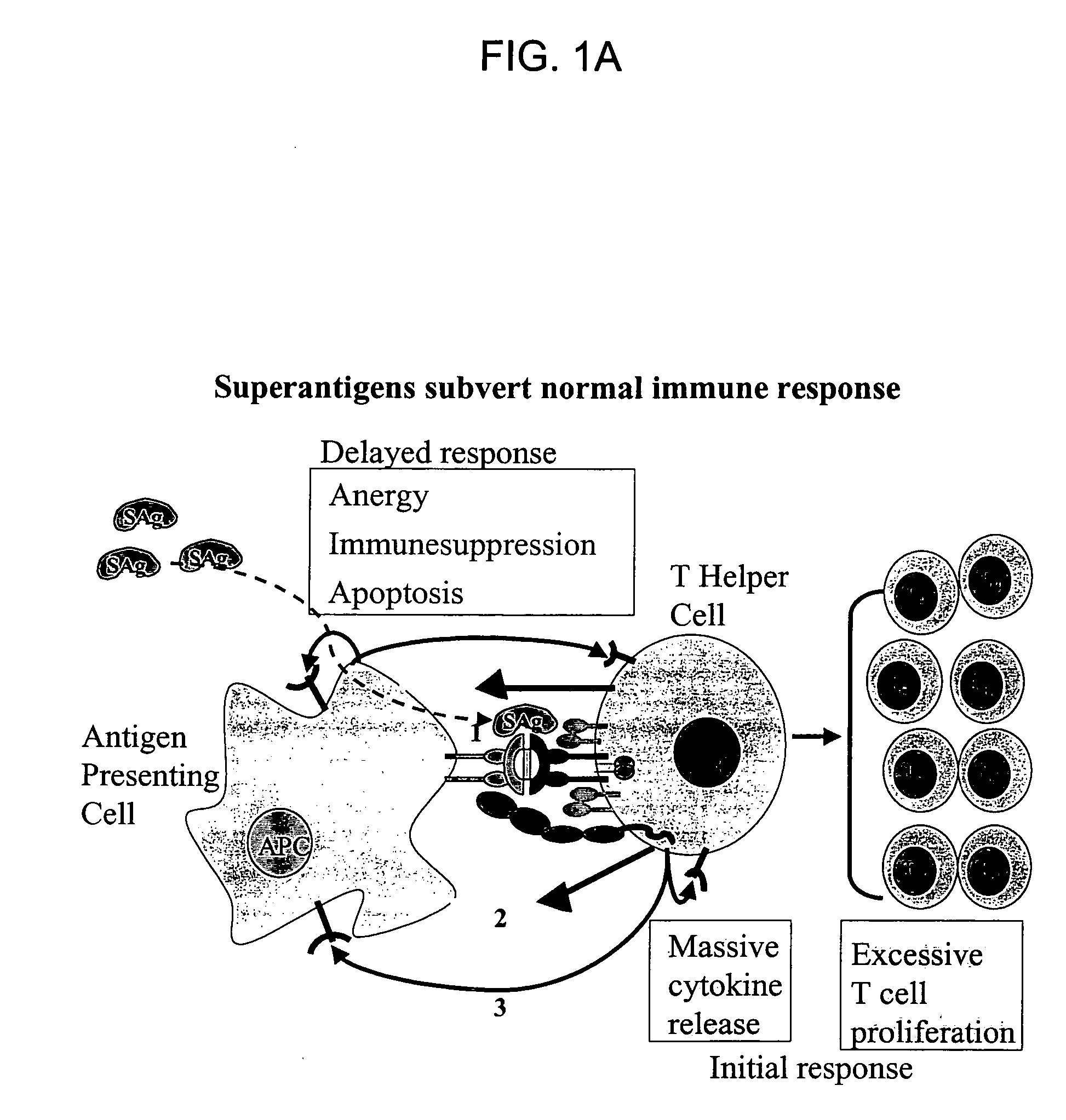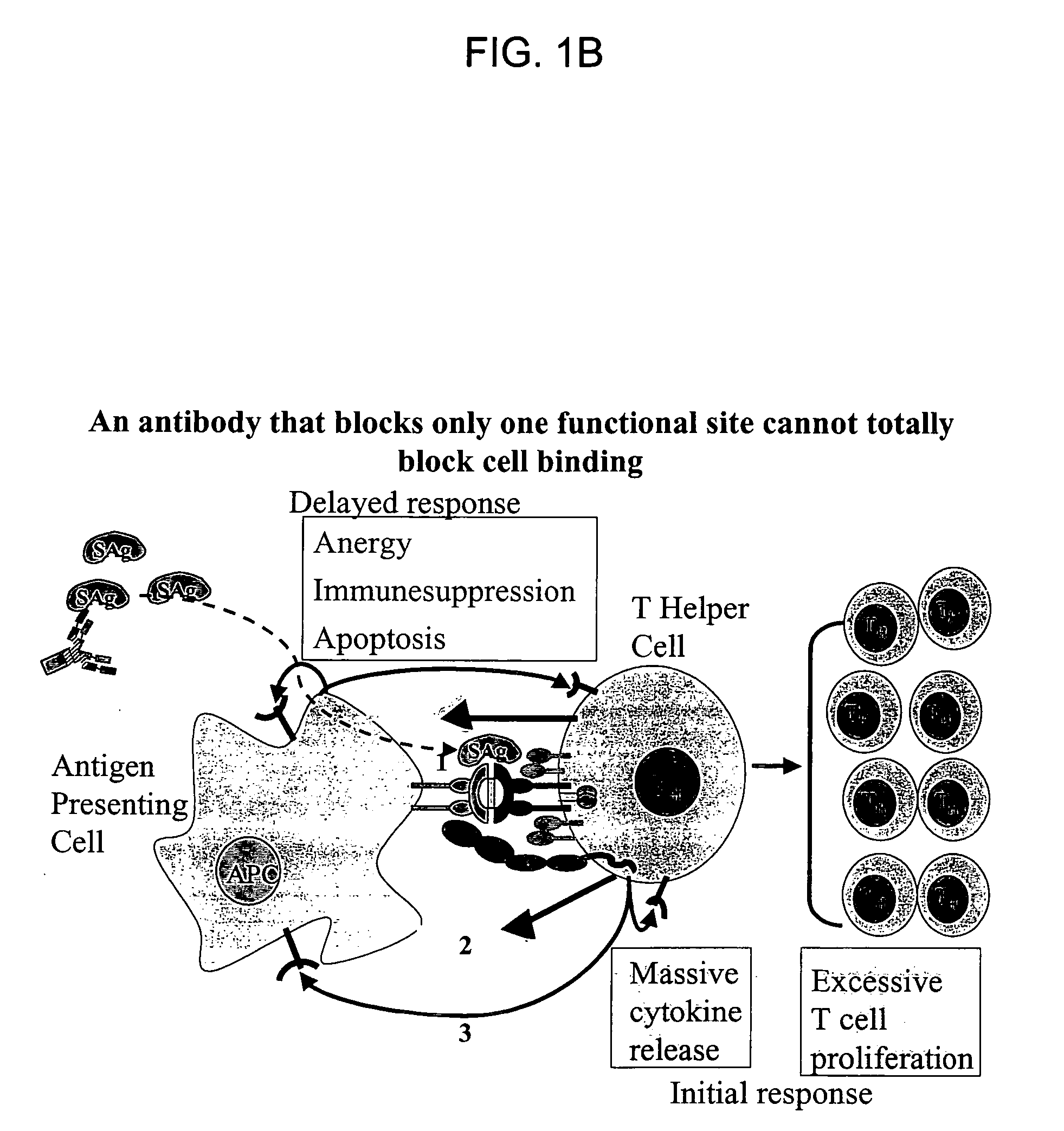Structure-based receptor MIMICS targeted against bacterial superantigen toxins
a structure-based receptor and superantigen technology, applied in the field of toxic shock syndrome, food poisoning, skin disorders, etc., can solve the problems of large t cell population, large cytokine release, and major health problems in the world
- Summary
- Abstract
- Description
- Claims
- Application Information
AI Technical Summary
Benefits of technology
Problems solved by technology
Method used
Image
Examples
example 2
Molecular Modeling
[0257] Materials and Methods:
[0258] A three-step molecular modeling study was conducted, as follows:
[0259] (I) The SAGs and their binding partners, MHC class II receptor and TCR, do not exhibit any significant structural changes upon complex formation. Also, structural studies indicate that SEB, SEC3 and TSST-1 engage in a similar spatial arrangement during contact with the MHC class II receptor (Sundberg and Mariuzza, 2002, Curr. Opin. Immunol. 14: 36-44; Arcus et al., 2002, J. Biol. Chem. 277: 32274-81). Thus, the initial models of the SAG / chimera complexes were constructed based on the crystallographic data as well as biochemical information on intermolecular contacts between DRα1 / TCRVβ and the SAGs. The following crystal structures from the Protein Data Bank (PDB) were used: (1) 1SEB, 1SBB for the SEB-chimera complex, (2) 1JCK and 1SEB for the SEC3-chimera complex, and (3) 1SEB, 2TSS and 1FYT for the TSST-1-chimera complex. The DR1α model for all three chime...
example 3
Molecular Modeling
[0282] An initial model of the complex between the superantigen and its chimeric receptor (DRα-GSTAPPAGSTAPPA-TcRVβ) targeted against three superantigens SEB, SEC3, and TSST-1 was constructed as follows.
[0283] For the SEB complex, the crystal structures of SEB-MHC Class II and SEB-TcR complexes were used (PDB identifiers 1SEB and 1SBB). For the SEC3 complex, the crystal structures of SEC3-TcR and SEB-MHC Class II complexes were used (1JCK and 1SEB) whereas the TSST-1 complex was built from the crystal structures of TSST-1, SEB-MHC class II, and MHC class II-HA-peptide-TcR complexes (2TSS, 1SEB and 1FYT).
[0284] SEB, SEC3, and TSST-1 require binding with only DRα and TcRVβ for their pathogenicity and show no metal dependence or any MHC class II β-chain binding (Kotb, 1998, Curr Opin Microbiol 1: 56-65). The length and sequence of the DRα and TcRVβ domains were chosen to ensure their native folds as present in full-length MHC class II and TcR (Lehnert et al., 2001,...
PUM
| Property | Measurement | Unit |
|---|---|---|
| concentration | aaaaa | aaaaa |
| concentrations | aaaaa | aaaaa |
| time | aaaaa | aaaaa |
Abstract
Description
Claims
Application Information
 Login to View More
Login to View More - R&D
- Intellectual Property
- Life Sciences
- Materials
- Tech Scout
- Unparalleled Data Quality
- Higher Quality Content
- 60% Fewer Hallucinations
Browse by: Latest US Patents, China's latest patents, Technical Efficacy Thesaurus, Application Domain, Technology Topic, Popular Technical Reports.
© 2025 PatSnap. All rights reserved.Legal|Privacy policy|Modern Slavery Act Transparency Statement|Sitemap|About US| Contact US: help@patsnap.com



